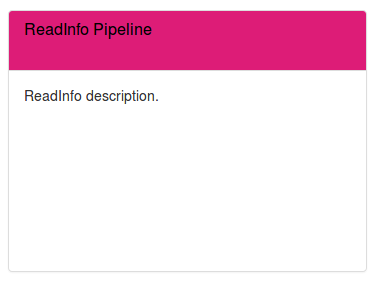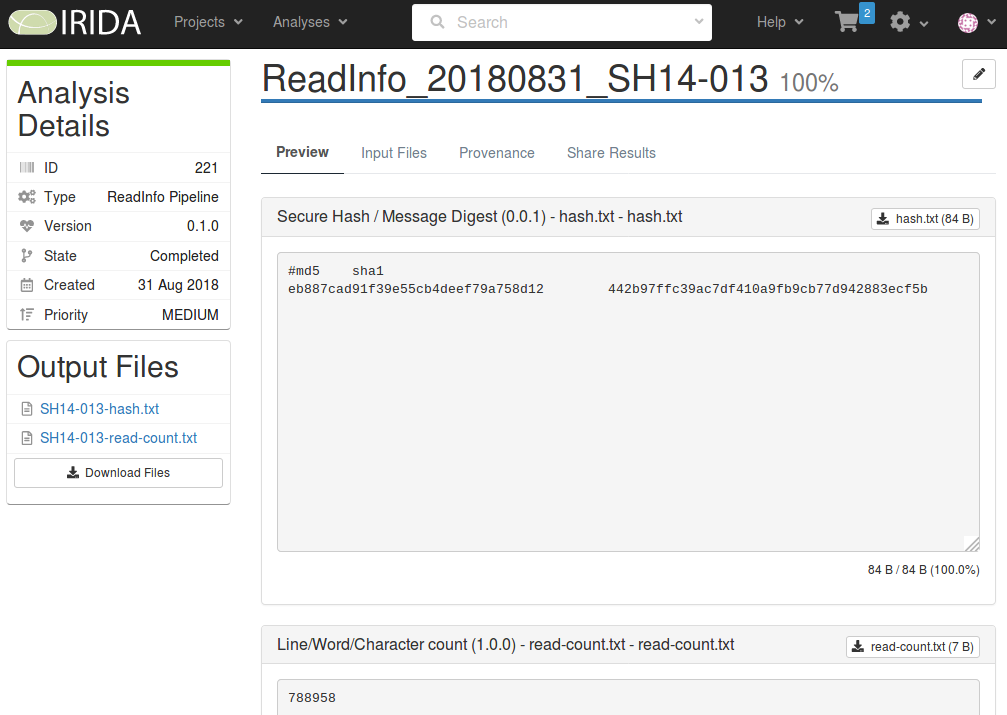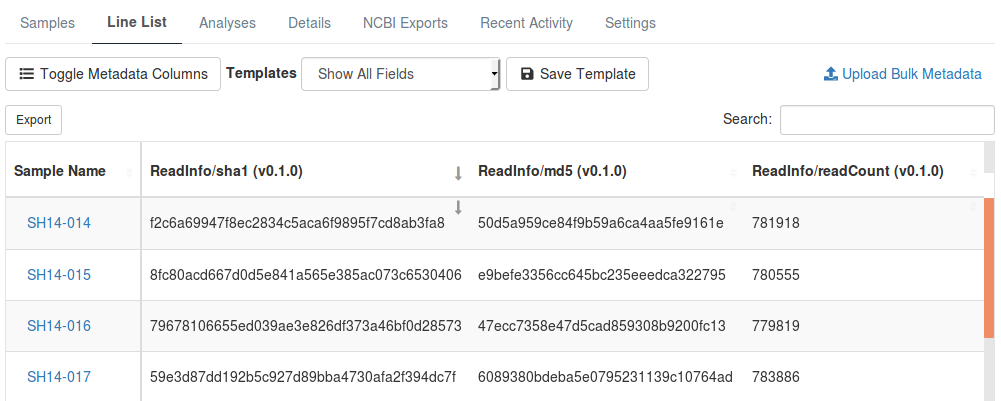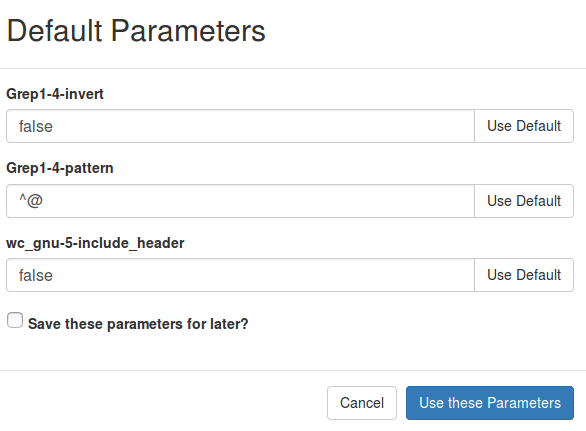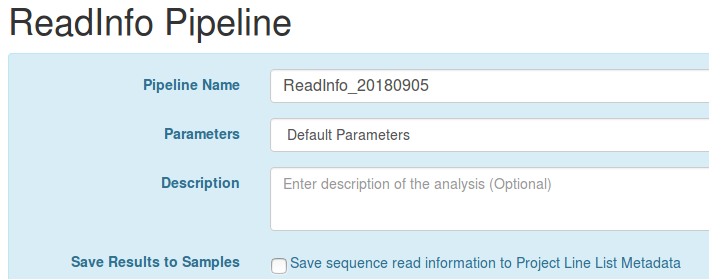This project contains an example pipeline implemented as a plugin for the IRIDA bioinformatics analysis system. This can be used as a template for implementing your own pipelines within IRIDA. Please see the pipeline documentation at https://irida.corefacility.ca/documentation/developer/tools/pipelines/ for more details.
- IRIDA Example Pipeline Plugin
- Building/Packaging
- Dependencies
- Using as a template for developing a plugin
Building and packaging this code is accomplished using Apache Maven. However, you will first need to install IRIDA to your local Maven repository. The version of IRIDA you install will have to correspond to the version found in the irida.version.compiletime property in the pom.xml file of this project. Right now, this is IRIDA version 19.01.3.
To install IRIDA to your local Maven repository please do the following:
- Clone the IRIDA project
git clone https://github.com/phac-nml/irida.git
cd irida- Checkout appropriate version of IRIDA
git checkout 19.01.3- Install IRIDA to local repository
mvn clean install -DskipTestsOnce you've installed IRIDA as a dependency, you can proceed to building this plugin. Please run the following commands:
cd irida-plugin-example
mvn clean packageOnce complete, you should end up with a file target/example-plugin-1.0-SNAPSHOT.jar which can be installed as a plugin to IRIDA.
If you have previously setup IRIDA before you may copy this JAR file to /etc/irida/plugins and restart IRIDA. The plugin should now show up in the Analyses > Pipelines section of IRIDA.
You should be able to run a pipeline with this plugin and get analysis results.
And, you should be able to save and view these results in the IRIDA metadata table.
The following dependencies are required in order to make use of this plugin.
In order to use this project as a template for developing your own pluginable pipeline there are a few places you will need to change.
1. Place necessary pipeline files in src/main/resources/workflows
The first set of files you will need to change are those under src/main/resources/workflows. The structure of this directory looks like:
workflows/
└── 0.1.0
├── irida_workflow_structure.ga
├── irida_workflow.xml
└── messages_en.properties
- The directory
0.1.0corresponds to all files for a particular version of a pipeline (in this case0.1.0). Previous versions of the pipeline should each be kept in their own numbered directory (e.g.,0.1.0,0.2.0) so that IRIDA can load up information about these pipelines. - The file
irida_workflow_structure.gais a Galaxy workflow file which is uploaded to a Galaxy instance by IRIDA before execution. - The file
irida_workflow.xmlcontains information about this particular pipeline used by IRIDA. - The file
messages_en.propertiescontains messages which will be displayed in the IRIDA UI.
Please replace any existing files in this directory using the following instructions.
The necessary files that go under the workflows/ directory can be constructed manually (see the IRIDA Pipeline development documentation). However, an easier approach is to construct the files automatically using the irida-wf-ga2xml software and then customize the generated files.
No matter which method you use (manually constructing the pipeline files, or automatically constructing them) you will need to start out by building your Galaxy workflow. Please follow the instructions in the IRIDA Pipelines documentation for how to do this. At the end, you should end up with a workflow.ga file exported from Galaxy, which is a JSON representation of your Galaxy workflow. Once you have this file (an example would be src/main/resources/workflows/0.1.0/irida_workflow_structure.ga), you can run the following to automatically generate the other necessary files:
java -jar irida-wf-ga2xml-1.0.0-SNAPSHOT-standalone.jar -n ReadInfo -t READ_INFO -W 0.1.0 -o output -i src/main/resources/workflows/0.1.0/irida_workflow_structure.gaThe meaning of the command-line options are as follows:
-n ReadInfo: The name of the pipeline, stored in the irida_workflow.xml file under<name>ReadInfo</name>.-t READ_INFO: The type of the pipeline, stored in the irida_workflow.xml file under<analysisType>READ_INFO</analysisType>. Corresponds to theAnalysisTypeobject in the Java file listed above (ExamplePlugin.java).-W 0.1.0: The version of the pipeline, stored in the irida_workflow.xml file under<version>0.1.0</version>.-o output: The directory to store all the output files.-i src/main/resources/workflows/0.1.0/irida_workflow_structure.ga: The input Galaxy workflow file.
Once complete, the output files will be located under output/ and will look like:
output/
└── ReadInfo
└── 0.1.0
├── irida_workflow_structure.ga
├── irida_workflow.xml
└── messages_en.properties
You can directly move the 0.1.0 directory to src/main/resources/workflows.
Once you've generated and moved your pipeline files to src/main/resources/workflows, you can make small adjustments to them as you see fit.
In particular, you may want to make adjustments to irida_workflow.xml to add/remove/change the parameters. These are stored in the XML file like:
<parameters>
<parameter name="Grep1-4-invert" defaultValue="false">
<toolParameter toolId="Grep1" parameterName="invert"/>
</parameter>
<parameter name="Grep1-4-pattern" defaultValue="^@">
<toolParameter toolId="Grep1" parameterName="pattern"/>
</parameter>
<parameter name="wc_gnu-5-include_header" defaultValue="false">
<toolParameter toolId="wc_gnu" parameterName="include_header"/>
</parameter>
</parameters>When loaded up in IRIDA, these will show up like:
You may also wish to modify the particular output files that get saved by IRIDA. These are recorded in:
<outputs>
<output name="hash.txt" fileName="hash.txt"/>
<output name="read-count.txt" fileName="read-count.txt"/>
</outputs>The fileName attribute should correspond to a particular name of an output file in the *.ga workflow file (see irida_workflow_stucture.ga or the IRIDA Pipeline documentation for more details).
The file src/main/resources/workflows/0.1.0/messages_en.properties contains the text that gets displayed by IRIDA for the pipeline. The file is in the form of key = value entries (the Java .properties format). An example of this file would be:
pipeline.parameters.modal-title.readinfo=ReadInfo Pipeline Parameters
workflow.READ_INFO.title=ReadInfo Pipeline
pipeline.h1.ReadInfo=ReadInfo Pipeline
pipeline.title.ReadInfo=Pipelines - ReadInfo
workflow.READ_INFO.description=
pipeline.parameters.readinfo.Grep1-4-invert=Grep1-4-invert
pipeline.parameters.readinfo.Grep1-4-pattern=Grep1-4-pattern
pipeline.parameters.readinfo.wc_gnu-5-include_header=wc_gnu-5-include_headerThe entries like workflow.READ_INFO.title=ReadInfo Pipeline contain the text used to display the pipeline entry on the "Pipelines" page in the UI:
The entries like pipeline.parameters.readinfo.Grep1-4-pattern=Grep1-4-pattern contain information used to display the text when adjusting pipeline parameters:
The Grep1-4-pattern part corresponds to the name attribute under a <parameter> entry in the irida_workflow.xml file:
<parameter name="Grep1-4-pattern" defaultValue="^@">
<toolParameter toolId="Grep1" parameterName="pattern"/>
</parameter>This is the main class you will need to modify for your pipeline. The class can be located in any package you wish, and can have any name you wish. You will want to implement the two methods which are indicated as required in this file. You can also override the methods indicated as optional in the file for additional configuration. You should have a class looking like:
public class ExamplePlugin extends Plugin {
public static final AnalysisType MY_ANALYSIS_TYPE = new AnalysisType("MY_ANALYSIS_TYPE");
public ExamplePlugin(PluginWrapper wrapper) {
super(wrapper);
}
@Extension
public static class PluginInfo implements IridaPlugin {
/*** Required ***/
@Override
public AnalysisType getAnalysisType() {
return new AnalysisType("READ_INFO");
}
@Override
public UUID getDefaultWorkflowUUID() {
return UUID.fromString("79d90ca8-00ae-441b-b5c7-193c9e85a968");
}
/*** Optional ***/
@Override
public Optional<Color> getBackgroundColor() {
return Optional.of(Color.decode("#dd1c77"));
}
@Override
public Optional<Color> getTextColor() {
return Optional.of(Color.BLACK);
}
@Override
public Optional<AnalysisSampleUpdater> getUpdater(MetadataTemplateService metadataTemplateService,
SampleService sampleService, IridaWorkflowsService iridaWorkflowsService) throws IridaPluginException {
return Optional.of(new ExamplePluginUpdater(metadataTemplateService, sampleService, iridaWorkflowsService));
}
}
}The purpose of each method is as follows:
-
getAnalysisType(): This returns anAnalysisTypeobject which stores the type of analysis as aString(matches the<analysisType>READ_INFO</analysisType>entry in the irida_workflow.xml file). -
getDefaultWorkflowUUID(): This returns the id of the workflow (matching the<id>79d90ca8-00ae-441b-b5c7-193c9e85a968</id>entry in the irida_workflow.xml file). Returning the appropriate value here is especially important if there are multiple versions of the same pipeline in this plugin (this will define the default or "latest" version). -
getBackgroundColor()andgetTextColor(): The background and text color to display in the UI (defaults to grey for background and black for text). This is optional. See example below: -
getUpdater(): Gets an instance of a class used for post-processing on pipeline results (e.g., updating the IRIDA metadata). This is optional. Additional documentation about this class is described below.
3. (Optional) Implement an Updater class
An Updater class is used to perform post-processing on the resulting files, primarily intended to write back pipeline results into the IRIDA metadata system. Please see the ExamplePluginUpdater.java for an example implementation, or the built-in implementations in https://github.com/phac-nml/irida/tree/development/src/main/java/ca/corefacility/bioinformatics/irida/pipeline/results/impl. Implementing this class is optional for your pipeline.
If you do implement this class, you will also want to make sure to update the messages_en.properties file with an entry like:
workflow.label.share-analysis-samples.READ_INFO=Save sequence read information to Project Line List MetadataThis contains the message to display asking the user if they wish to Save Results to Samples for their pipeline before launching the pipeline.
4. Update the pom.xml file
You will have to update the pom.xml file in order to set version information and other metadata about your pipeline.
You will want to update the Maven version/information section for this particular plugin. That is:
<groupId>ca.corefacility.bioinformatics.irida.plugins</groupId>
<artifactId>example-plugin</artifactId>
<version>0.1.0-SNAPSHOT</version>Please see the Maven Documentation for more details.
The properties section contains additional information you will have to update. In particular:
<plugin.id>example-plugin</plugin.id>
<plugin.class>ca.corefacility.bioinformatics.irida.plugins.ExamplePlugin</plugin.class>
<plugin.version>0.1.0</plugin.version>
<plugin.provider>Aaron Petkau</plugin.provider>
<plugin.dependencies></plugin.dependencies>
<plugin.requires.runtime>1.0.0</plugin.requires.runtime>
<irida.version.compiletime>0.23.0-SNAPSHOT</irida.version.compiletime>The <plugin.*> entries contain information about your particular plugin as defined by PF4J.
plugin.id: An identifier for your plugin.plugin.class: The fully-qualified name of the class implementing this plugin (in this case, the ExamplePlugin.java class).plugin.version: A version number for your plugin.plugin.provider: The provider of this plugin.plugin.dependencies: Other IRIDA plugins this plugin depends on.plugin.requires.runtime: The exact version of the IRIDA plugin API this plugin requires at runtime (stored in the IridaPlugin.java interface). You normally don't need to update this unless the version is also updated in IRIDA.
The <irida.version.compiletime> contains the exact IRIDA version this plugin will need to be compiled against (compile-time version).
Once you've made all the updates, you can try building and testing your plugin. To build your plugin, you can run:
mvn clean packageYou should find your packaged plugin JAR file in target/ (e.g., target/example-plugin-0.1.0-SNAPSHOT.jar).
To test out this plugin, please copy to /etc/irida/plugins on a machine with IRIDA installed and restart IRIDA. Your plugin should show up in the Analyses > Pipelines page in IRIDA.
You should also be able to see messages like below in the IRIDA log file when starting up:
INFO org.pf4j.AbstractPluginManager:801 - Plugin 'example-plugin@0.1.0' resolved
INFO org.pf4j.AbstractPluginManager:320 - Start plugin 'example-plugin@0.1.0'
DEBUG ca.corefacility.bioinformatics.irida.config.services.IridaPluginConfig:45 - Loaded 1 valid pipeline plugins.
Once you've successfully built your plugin, you can distribute the JAR file to other IRIDA users to install in their instances.
